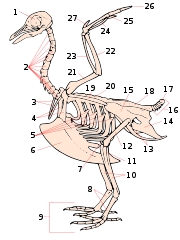
Tarsometatarsus
Encyclopedia

Tetrapod
Tetrapods are vertebrate animals having four limbs. Amphibians, reptiles, birds and mammals are all tetrapods; even snakes and other limbless reptiles and amphibians are tetrapods by descent. The earliest tetrapods evolved from the lobe-finned fishes in the Devonian...
s, namely bird
Bird
Birds are feathered, winged, bipedal, endothermic , egg-laying, vertebrate animals. Around 10,000 living species and 188 families makes them the most speciose class of tetrapod vertebrates. They inhabit ecosystems across the globe, from the Arctic to the Antarctic. Extant birds range in size from...
s.
It is formed from the fusion of several bones found in other types of animals, and homologous to the mammalian tarsal
Tarsus (skeleton)
In tetrapods, the tarsus is a cluster of articulating bones in each foot situated between the lower end of tibia and fibula of the lower leg and the metatarsus. In the foot the tarsus articulates with the bones of the metatarsus, which in turn articulate with the bones of the individual toes...
(ankle) and metatarsal
Metatarsus
The metatarsus or metatarsal bones are a group of five long bones in the foot located between the tarsal bones of the hind- and mid-foot and the phalanges of the toes. Lacking individual names, the metatarsal bones are numbered from the medial side : the first, second, third, fourth, and fifth...
(foot) bones. Despite this, the tarsometatarsus of birds is often referred to as just the tarsus or metatarsus.
There are several ways and extents in which the tarsometatarsal fusion is accomplished throughout bird evolution
Evolution
Evolution is any change across successive generations in the heritable characteristics of biological populations. Evolutionary processes give rise to diversity at every level of biological organisation, including species, individual organisms and molecules such as DNA and proteins.Life on Earth...
. Namely, in Neornithes (modern birds) the fusion is most thorough at the distal (metatarsal) end though present along the entire length of the bone. In the Enantiornithes
Enantiornithes
Enantiornithes is an extinct group of primitive birds. They were the most abundant and diverse avialans of the Mesozoic. Almost all retained teeth and clawed fingers on each wing, but otherwise looked much like modern birds externally. Over 50 species of Enantiornithines have been named, but some...
, a group of Mesozoic
Mesozoic
The Mesozoic era is an interval of geological time from about 250 million years ago to about 65 million years ago. It is often referred to as the age of reptiles because reptiles, namely dinosaurs, were the dominant terrestrial and marine vertebrates of the time...
birds, the fusion was complete at the proximal (tarsal) end but the distal metatarsi still were somewhat separate.

Parallel evolution
Parallel evolution is the development of a similar trait in related, but distinct, species descending from the same ancestor, but from different clades.-Parallel vs...
, a tarsometatarsus was also present in the Heterodontosauridae
Heterodontosauridae
Heterodontosauridae is a family of early ornithischian dinosaurs that were likely among the most basal members of the group...
, a group of tiny ornithopod
Ornithopod
Ornithopods or members of the clade Ornithopoda are a group of ornithischian dinosaurs that started out as small, bipedal running grazers, and grew in size and numbers until they became one of the most successful groups of herbivores in the Cretaceous world, and dominated the North American...
dinosaurs quite unrelated to birds. Their oldest remains date from the Late Triassic
Late Triassic
The Late Triassic is in the geologic timescale the third and final of three epochs of the Triassic period. The corresponding series is known as the Upper Triassic. In the past it was sometimes called the Keuper, after a German lithostratigraphic group that has a roughly corresponding age...
more than 200 million years ago, and predate the first birds with a tarsometatarsus by nearly 100 million years.

